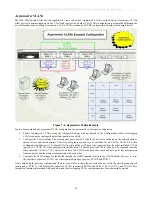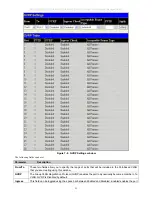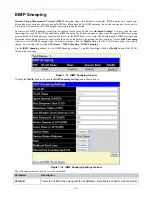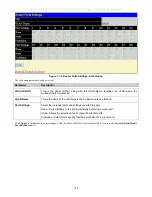
DES-3028 DES-3028P DES-3028G DES-3052 DES-3052P Layer 2 Fast Ethernet Managed Switch
Trunking
Port trunk groups are used to combine a number of ports together to make a single high-bandwidth data pipeline.
The Switch supports up to six port trunk groups with 2 to 8 ports in each group. A potential bit rate of 800 Mbps can be achieved.
Figure 7- 11. Example of Port Trunk Group
The Switch treats all ports in a trunk group as a single port. Data transmitted to a specific host (destination address) will always be
transmitted over the same port in a trunk group. This allows packets in a data stream to arrive in the same order they were sent.
NOTE:
If any ports within the trunk group become disconnected, packets
intended for the disconnected port will be load shared among the other
uplinked ports of the link aggregation group.
Link aggregation allows several ports to be grouped together and to act as a single link. This gives a bandwidth that is a multiple
of a single link's bandwidth.
Link aggregation is most commonly used to link a bandwidth intensive network device or devices, such as a server, to the
backbone of a network.
The Switch allows the creation of up to six link aggregation groups, each group consisting of 2 to 8 links (ports). All of the ports
in the group must be members of the same VLAN, and their STP status, static multicast, traffic control, traffic segmentation and
802.1p default priority configurations must be identical. Port locking, port mirroring and 802.1X must not be enabled on the trunk
group. Further, the aggregated links must all be of the same speed and should be configured as full-duplex.
The Master Port of the group is to be configured by the user, and all configuration options, including the VLAN configuration that
can be applied to the Master Port, are applied to the entire link aggregation group.
Load balancing is automatically applied to the ports in the aggregated group, and a link failure within the group causes the
network traffic to be directed to the remaining links in the group.
The Spanning Tree Protocol will treat a link aggregation group as a single link, on the switch level. On the port level, the STP will
use the port parameters of the Master Port in the calculation of port cost and in determining the state of the link aggregation group.
If two redundant link aggregation groups are configured on the Switch, STP will block one entire group, in the same way STP will
block a single port that has a redundant link.
98
Summary of Contents for DES-3028
Page 306: ......
Page 307: ......
Page 327: ...D Link D Link D Link D Link 7 495 744 00 99 http www dlink ru e mail support dlink ru...
Page 332: ...Technical Support Web Web URL http www dlink jp com...
















































